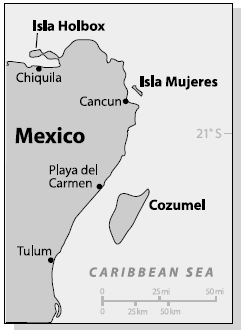Holbox Island, Quintana Roo, MexicoContents of this Issue: Holbox Island, Quintana Roo, Mexico Sixteen Divers Surface to Find Boat Missing The Divi Tiara Resort, Cayman Brac When the Weather Cancels Your Diving Faulty Oceanic and Aeris BC Inflators Get a Grip: Manta Bite Mouthpiece Malaria and Divers: Even in Róatán there’s a risk. Editorial Office: Ben Davison Publisher and Editor Undercurrent 3020 Bridgeway, Suite 102 Sausalito, CA 94965 some big, big surprises from the October, 2004 issue of Undercurrent
Dear Fellow Diver, About a three-hour drive and a six-mile ferry crossing from Cancun is a tropical little Mexican island where restaurants serve pasta and pizza, and chips and salsa are almost an afterthought. The small dusty village on the island of Holbox (pronounced ólbosch) isn’t on anyone’s itinerary, save for a few Texans and a handful of Italians who, for reasons only they know, have settled there. The central plaza features a Spartan basketball court, a small white cathedral, and a few vendors. Each evening, someone pulls the church bell rope to send riveting chimes through the quaint village.Palm-thatched huts, some without plumbing, contrast with brightly painted block homes. Lobster and squid fishermen comprise most of the 800 inhabitants, few of whom speak English. Locals walk, bicycle, or use golf carts to navigate unpaved streets. It’s hotter than hell, and just as humid during the summer (90+F degrees), and mosquitoes outnumber the residents. And, for as long as anyone can remember, the fishermen have tolerated the scores of thirty-foot fish that ply their waters in July and August, just making sure to keep alert so they wouldn’t capsize their small craft. Besides, “Mexican women are winky-winky about whale sharks,” I was told. An Eritrean woman by birth, Ornella Alemanni isn’t
winky winky. Years ago, Onny married an Italian named
Carmelo Alemanni. While vacationing in Kenya, they went diving
in a popular destination for Italians, the Malindi Marine
National Park, where they had exciting whale shark encounters.
Years later, traveling from their home in Italy, they
visited Holbox, eventually returning to open a waterfront
posada with eleven thatched roof huts that they named
Mawimbi. Recognizing the value of the scores of whale sharks
that came to feed on upwellings of plankton each summer, Onny
began taking a few tourists to view them on her 25-foot
“launcha.” In August, three friends and I visited Holbox, and I was overwhelmed. Each morning at 7:00 a.m., I walked 25-feet across a white sandy beach from my thatch-roofed hut. Wading knee-deep into the water, I climbed over the gunwales and into Captain Miguel Vega’s small launcha Buena Onda, (“everything is good”). Our first stop was the pier just minutes away, where officials of the Yum Balam Reserve check each outgoing boat for its permit (every boat must have a licensed captain and a certified guide; 32 boats were granted permits, but only 12 are active) and verified that passengers were wearing life jackets (which we doffed once out of eyesight). Miguel Vega then revved up his single 150 hp engine to speed 40 minutes south along the beach, then turned east for 20-minutes into the Gulf of Mexico. Using his hand-held GPS, he homed in on the coordinates where the whale sharks tend to congregate, joining up with ten other small boats carrying off-the-beaten-path tourists who paid $80US in the plaza for a “tiburon balleña” tour. Our guide Juan reminded us of the rules (written last year because people were grabbing the whale sharks and speeding boats were frightening them): no touching, only two snorkelers in the water at once, and only one boat per whale shark. Suddenly, excited hoops and hollers echoed across the water. The surface boiled, while as many as sixty whale sharks, moved slowly, mouths agape, through the plankton rich waters. Entering the water directly in a whale shark’s path, I peered into its approaching mouth. A few feet away, its eyes appeared to check me out (though that may be anthropomorphic). Some fed in circles, giving me a second or even a third encounter, where I could see attached remoras dining on parasites. Schools of sardines, a frenetic bait ball breaking the surface, gobbled anything escaping the gaping mouth. Cobia, playing the roles of pilot fish, kept pace with the shark’s strong strokes. Two of us would slide into the 79-degree water with one or two whale sharks to observe and photograph them. Visibility ranged from 25-30 feet, enough to give me a great view, but not enough to capture the shark’s full length with my digital and video equipment. I made at least half a dozen entries, lasting up to fifteen minutes each. As two of us came out, the mate helped us up a side ladder as the boat idled. We never had to wait to find the next whale shark. Viewing the whale sharks from the boats was almost as exciting. It was thrilling to watch my buddies share this incredible experience. “Swim to your left or right,” I shouted, if I spotted a shark heading in their direction or one they could intercept. As comfortable as the polka-dotted creatures -- the locals call them “dominoes” -- appeared (they were barely moving), their strong bodies swept through the water faster than I could fin -- the current from their sweeping tails often pushed me forcefully through the water. After a tail hit my buddy’s leg, she wore her bruise like a badge of honor. One whale shark snuggled along the side of the boat like it wanted to be petted -- could I resist giving it a gentle pat? When the afternoon wind picked up, the plankton descended deeper and the dominoes followed, so we returned to shore. The next morning we departed earlier to beat other boats, but, damn, the sharks were gone! When other boats arrived, we all fanned out in search of them. Miguel speculated that they might have headed south toward the uninhabited island of Contoy, a bird sanctuary (flamingoes, roseate spoonbills, cormorants, pelicans, ibis and herons). A seamount that rises to a depth of 5 feet five miles north of Contoy also attracts the whale sharks. But we had a problem. We didn’t have enough gas to make the hour round trip. When Miguel said we could chance buying fuel from a fisherman, without hesitation we said, “vámanos,” let’s go! As we headed south, the other boats followed. Soon we were again surrounded by whale sharks, so many we could have floated in the water and waited for one to swim by. We were now 48-miles from Holbox. Since we were flying to Cozumel at 3:00 p.m. that afternoon, around noon we sadly departed. Luckily a fisherman’s gas barge was near the south end of Isla Holbox. Siphoning gas into a plastic container, Miguel passed over some money and refilled our nearly empty tank. My whale shark experience was clearly worth “roughing it” in Holbox. At the Mawimbi, only one room is air-conditioned. Onny has no confidence in air conditioning because Holbox’s generator frequently shuts down. That’s a problem for the few air-conditioned hotels, because some don’t have windows that open. Mawimbi has the benefit of gentle ocean breezes. Its thatched roof huts have a rustic charm, twin serape-covered beds, but no amenities other than small refrigerators, but the place is immaculate with tile floors, wooden beams, and large bathrooms with painted ceramic sinks. And the price is right; $50-90/night, and all rooms were taken. (A word for the wise: reserve well in advance). None of the restaurants is air-conditioned. At Cueva del Pirata, across from the plaza, we sat at a table along the dusty road to enjoy the evening breeze. The food was okay. Around the corner is Villa Zapata, an upstairs restaurant that also serves Italian food. Across the plaza was a busy pizza place. Oddly, the Ringling Circus was in town. Tents had been set up next to Mawimibi, so after dinner I listened to blaring techno-music before drifting off. While one can easily drive their ferry to Holbox, we had arranged a six-passenger Aero Saab charter plane for $1200 round trip from Cancun. We were to be met outside customs, but when no one showed, we hauled our gear about a quarter-mile in the heat to the General Aviation terminal. Though we had explained in advance that we each had 100 pounds of luggage, the pilot took one look at our dive bags and said they were too bulky to fit in the baggage fuselage of our single engine Cessna 206. We rummaged through our baggage, took what we needed, and sent the remainder to our next stop, Cozumel, and the Hotel Cozumel (Terrible place; the rooms are dirty and mosquitofilled, the staff has no notion of service, and the food is inedible. The hotel is no longer listed on any website so it probably was going out of business.). Thirty-five minutes later we landed on the 2000-foot dirt runway in Holbox, where a golf cart “taxi” met us. We spent two days with the whale sharks, just enough, I think, making it a nice extension for any trip to the Yucatan. The airstrip was only a few minutes from the hotel. On the way out, our taxi driver toured the village and was headed to the ferry landing before we reminded him we were headed to the airport. He had never been there. -- G.S.
|

I want to get all the stories! Tell me how I can become an Undercurrent Online Member and get online access to all the articles of Undercurrent as well as thousands of first hand reports on dive operations world-wide
| Home | Online Members Area | My Account |
Login
|
Join
|
| Travel Index |
Dive Resort & Liveaboard Reviews
|
Featured Reports
|
Recent
Issues
|
Back Issues
|
|
Dive Gear
Index
|
Health/Safety Index
|
Environment & Misc.
Index
|
Seasonal Planner
|
Blogs
|
Free Articles
|
Book Picks
|
News
|
|
Special Offers
|
RSS
|
FAQ
|
About Us
|
Contact Us
|
Links
|
3020 Bridgeway, Ste 102, Sausalito, Ca 94965
All rights reserved.

 Soon, fishermen who couldn’t even swim were selling whale shark trips to the tourists and now,
just three years later, it’s on the verge of being
discovered. In fact, as an Undercurrent subscriber,
you’re among the first to know, because
no one else has covered this phenomenon.
Soon, fishermen who couldn’t even swim were selling whale shark trips to the tourists and now,
just three years later, it’s on the verge of being
discovered. In fact, as an Undercurrent subscriber,
you’re among the first to know, because
no one else has covered this phenomenon. Divers Compass: From Cancun, you can rent a car or cab. Highway
180 to Nuevo Xcan, turning north toward Kantunilkín and the port
of Chiquilá, a three-hour drive on a pothole-riddled road, then
park your car. It’s $2.50 for the 30-minute ride (passengers
only). The last ferry is at 5 pm. You can hire a launcha from one
of the men waiting around the dock for $20 ... .Posada Mawimbi;
telephone and fax 911 52 984 8752003 or
Divers Compass: From Cancun, you can rent a car or cab. Highway
180 to Nuevo Xcan, turning north toward Kantunilkín and the port
of Chiquilá, a three-hour drive on a pothole-riddled road, then
park your car. It’s $2.50 for the 30-minute ride (passengers
only). The last ferry is at 5 pm. You can hire a launcha from one
of the men waiting around the dock for $20 ... .Posada Mawimbi;
telephone and fax 911 52 984 8752003 or 